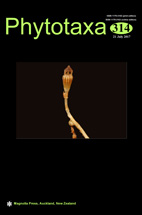Abstract
Because of phenotypic plasticity, undefined specific boundaries, and specimens that are rarely fertile, species recognition in Gelidiales has been extremely difficult and controversial. Fifteen species of Gelidiellaceae and Gelidiaceae have been reported in Brazil with the majority in regional floristic studies or species lists. Thus, Gelidiales species have not received enough attention in Brazil, and many taxonomic problems remain unresolved. In this study, an integrative systematic approach based on the morphology of the vegetative and reproductive structures and two molecular markers, cox1 and rbcL, was used for 54 samples collected along the Brazilian coast. Five Gelidiaceae, including Gelidium crinale, G. floridanum, G. lineare, G. microdonticum and a new species here proposed as G. calidum, were found. The occurrence of Gelidiella acerosa, Ge. flabella, Millerella myrioclada, and two undescribed species, Gelidiella sp. and Millerella sp. were confirmed in Gelidiellaceae. Gelidiaceae and Gelidiellaceae species could be distinguished from each other by molecular and morphological approaches, except for Gelidium crinale and the new species, G. calidum, which were distinguished only by molecular data.

